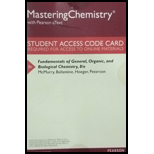
(a)
Interpretation:
The given molecule is whether a carboxylic acid, an amide or an ester has to be determined. The condensed and all line structure of the given molecule has to be determined
Concept introduction:
Functional group: They are certain substitutes in the organic molecules which are determine the characteristic reactions taking place in it.
Carboxylic acid: One
The derivatives of carboxylic acid are ester, amide
Ester: One
Amide: One
In chemistry Structure is the arrangement of chemical bonds between atoms in a molecule, specifically which atoms are chemically bonded to what other atoms with what kind of chemical bond.
In Line structure,
- Only shows bonds.
- C atoms assumed at each end and intersection of bonds
- H atoms are not shown.
- Assume 4 bonds to each C
- Fulfill C’s 4 bonds by adding hydrogens.
In condensed structure representation,
- Some or all of the lines are omitted and atoms attached to carbon are written immediately after it.
(b)
Interpretation:
The given molecule is whether a carboxylic acid, an amide or an ester has to be determined. The condensed and all line structure of the given molecule has to be determined
Concept introduction:
Functional group: They are certain substitutes in the organic molecules which are determine the characteristic reactions taking place in it.
Carboxylic acid: One
The derivatives of carboxylic acid are ester, amide
Ester: One
Amide: One
In chemistry Structure is the arrangement of chemical bonds between atoms in a molecule, specifically which atoms are chemically bonded to what other atoms with what kind of chemical bond.
In Line structure,
- Only shows bonds.
- C atoms assumed at each end and intersection of bonds
- H atoms are not shown.
- Assume 4 bonds to each C
- Fulfill C’s 4 bonds by adding hydrogens.
In condensed structure representation,
- Some or all of the lines are omitted and atoms attached to carbon are written immediately after it.
(c)
Interpretation:
The given molecule is whether a carboxylic acid, an amide or an ester has to be determined. The condensed and all line structure of the given molecule has to be determined
Concept introduction:
Functional group: They are certain substitutes in the organic molecules which are determine the characteristic reactions taking place in it.
Carboxylic acid: One
The derivatives of carboxylic acid are ester, amide
Ester: One
Amide: One
In chemistry Structure is the arrangement of chemical bonds between atoms in a molecule, specifically which atoms are chemically bonded to what other atoms with what kind of chemical bond.
In Line structure,
- Only shows bonds.
- C atoms assumed at each end and intersection of bonds
- H atoms are not shown.
- Assume 4 bonds to each C
- Fulfill C’s 4 bonds by adding hydrogens.
In condensed structure representation,
- Some or all of the lines are omitted and atoms attached to carbon are written immediately after it.
Want to see the full answer?
Check out a sample textbook solution
Chapter 17 Solutions
Fund. of General, Org... -Masteringchem.
- For the first part, draw a Fischer projection formula for the enantiomer of each of the following monosaccharides. For the second part, identify whether the images are in D- or L-configuration. Write your answers first on a piece of bond paper.arrow_forwardIdentify the circled functional groups and linkages in the compound shown below.arrow_forwardDraw condensed structural formulas for the two carboxylic acids with the molecular formula C4H8O2arrow_forward
- Which of the following Fischer formula is or are monosaccharide that has two chiral centers?arrow_forwardDraw the structure of the tripeptide alanylglycylvaline and determine its name using three-letter abbreviations.arrow_forwardWhat is the “octet rule” and its biologically important exception?arrow_forward
- Identify the functional groups in the followingmolecules.arrow_forwardIdentify the monomers for the following polymers A.) Maltose B.) Sucrose C.) Lactosearrow_forwardAre the following molecules chiral or achiral? If they are chiral, identify the chiral carbon atom(s).(a) Pentan-3-ol (b) 2-Bromobutane(c) 2-Methylcyclohexanolarrow_forward
 BiochemistryBiochemistryISBN:9781319114671Author:Lubert Stryer, Jeremy M. Berg, John L. Tymoczko, Gregory J. Gatto Jr.Publisher:W. H. Freeman
BiochemistryBiochemistryISBN:9781319114671Author:Lubert Stryer, Jeremy M. Berg, John L. Tymoczko, Gregory J. Gatto Jr.Publisher:W. H. Freeman Lehninger Principles of BiochemistryBiochemistryISBN:9781464126116Author:David L. Nelson, Michael M. CoxPublisher:W. H. Freeman
Lehninger Principles of BiochemistryBiochemistryISBN:9781464126116Author:David L. Nelson, Michael M. CoxPublisher:W. H. Freeman Fundamentals of Biochemistry: Life at the Molecul...BiochemistryISBN:9781118918401Author:Donald Voet, Judith G. Voet, Charlotte W. PrattPublisher:WILEY
Fundamentals of Biochemistry: Life at the Molecul...BiochemistryISBN:9781118918401Author:Donald Voet, Judith G. Voet, Charlotte W. PrattPublisher:WILEY BiochemistryBiochemistryISBN:9781305961135Author:Mary K. Campbell, Shawn O. Farrell, Owen M. McDougalPublisher:Cengage Learning
BiochemistryBiochemistryISBN:9781305961135Author:Mary K. Campbell, Shawn O. Farrell, Owen M. McDougalPublisher:Cengage Learning BiochemistryBiochemistryISBN:9781305577206Author:Reginald H. Garrett, Charles M. GrishamPublisher:Cengage Learning
BiochemistryBiochemistryISBN:9781305577206Author:Reginald H. Garrett, Charles M. GrishamPublisher:Cengage Learning Fundamentals of General, Organic, and Biological ...BiochemistryISBN:9780134015187Author:John E. McMurry, David S. Ballantine, Carl A. Hoeger, Virginia E. PetersonPublisher:PEARSON
Fundamentals of General, Organic, and Biological ...BiochemistryISBN:9780134015187Author:John E. McMurry, David S. Ballantine, Carl A. Hoeger, Virginia E. PetersonPublisher:PEARSON





